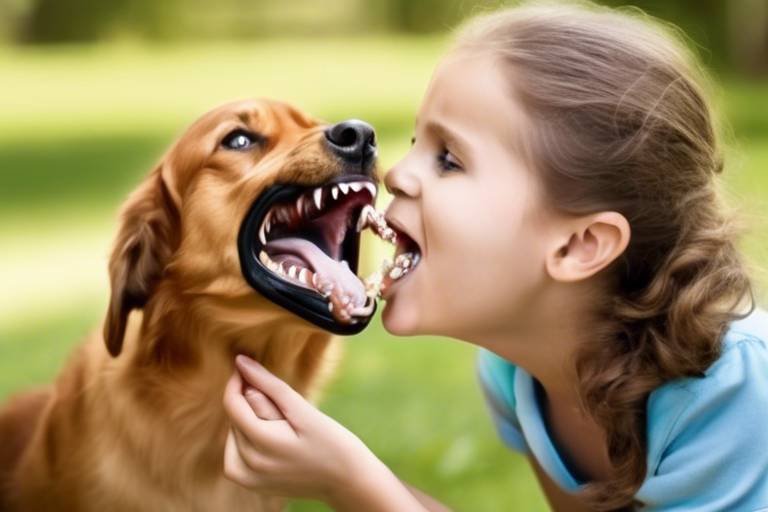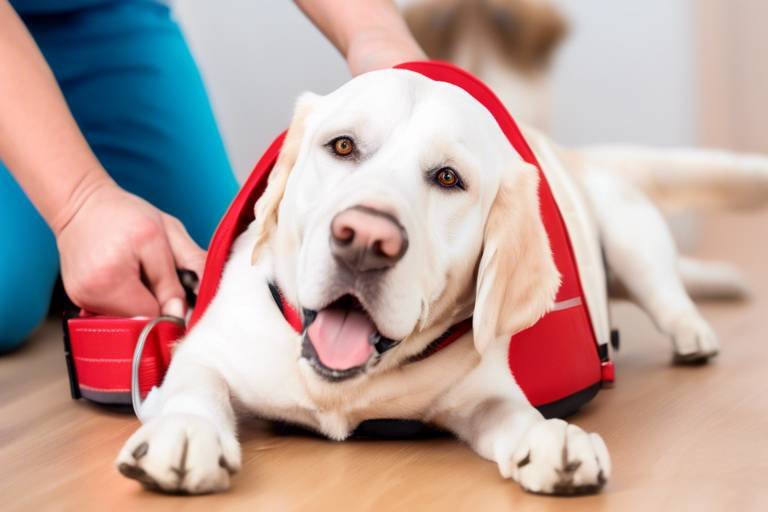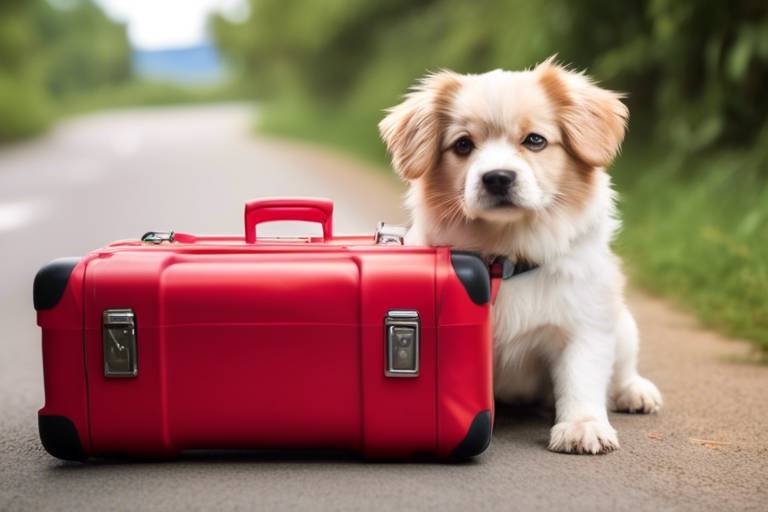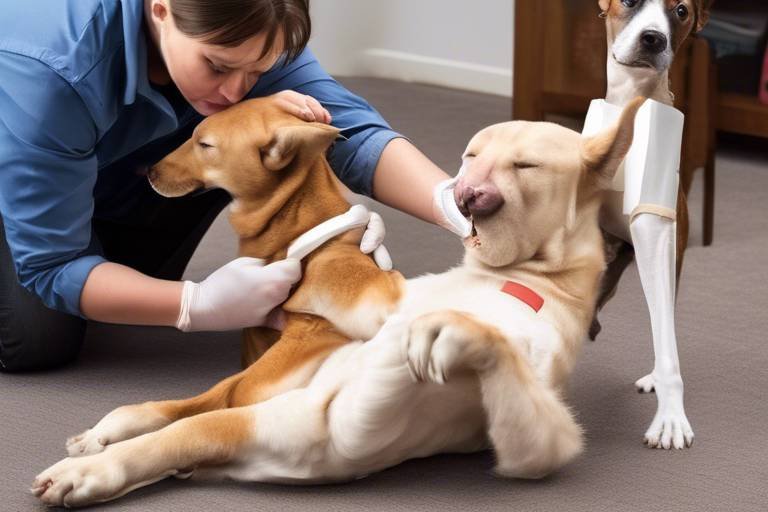How to Help Your Pet Adjust to a New Home Safely
Moving to a new home can be an exciting adventure for you, but it can also be a confusing and stressful experience for your furry friend. Just like us, pets thrive on stability and familiarity. When their world gets turned upside down, they may feel anxious, scared, or even overwhelmed. So, how can you help your pet transition smoothly into this new environment? In this article, we’ll explore essential tips and strategies that focus on emotional support, safety, and creating a comfortable space for your beloved companion. By the end, you'll be equipped with the knowledge to make this transition as seamless as possible for your pet.
Recognizing how pets feel during a move is crucial. They can experience a range of emotions from excitement to fear. For instance, some pets may exhibit signs of anxiety such as excessive barking, hiding, or loss of appetite. Others might seem curious but are actually feeling overwhelmed. It's important to pay attention to these behaviors and address them effectively. Consider spending extra time with your pet during this period. Just like a child needs reassurance when faced with change, your pet needs your comfort and support. Talk to them softly, pet them gently, and let them know that everything will be okay.
Creating a pet-friendly environment is vital for your pet's comfort and safety. Before your furry friend arrives, make sure to remove any potential hazards around the house. This includes securing loose wires, removing toxic plants, and ensuring that windows and balconies are safe. Additionally, consider the layout of your home. Is there a quiet corner where your pet can retreat to if they feel overwhelmed? Setting up a space that allows them to feel secure can make a world of difference in their adjustment period.
Selecting an appropriate area for your pet can significantly impact their comfort. Ideally, this space should be away from the hustle and bustle of your new home. Think of it as a little sanctuary for your pet—a place where they can relax and feel safe. Factors to consider include proximity to family activity and noise levels. If you have a dog, a cozy corner in the living room may work, while a cat might prefer a quiet nook in a less-trafficked area.
A cozy bed can help your pet feel secure. When choosing bedding, consider your pet's size and sleeping habits. For example, a dog that loves to sprawl may need a larger bed, while a cat who likes to curl up might prefer something smaller and enclosed. Placing the bed in their designated space will help them recognize it as their own. Remember, a comfortable bed is not just a luxury; it's a necessity for your pet's well-being.
Having the right supplies ready can ease your pet's transition. Here’s a quick checklist of must-have items to ensure your pet feels at home immediately:
- Food and water bowls
- Quality pet food
- Comfortable bedding
- Toys for mental stimulation
- Leash and collar (for dogs)
- Litter box and litter (for cats)
By preparing these essentials ahead of time, you can create a welcoming environment that helps your pet feel at home right away.
Consistency is key to helping your pet adjust. Just like humans thrive on routine, pets feel more secure when they know what to expect. Establish a daily schedule for feeding, walks, and playtime. This routine not only helps your pet feel more comfortable but also strengthens your bond. For instance, if you usually feed your dog at 7 AM, continue that routine in your new home. This familiarity can be very soothing for them.
Gradually exposing your pet to different areas of your new home can prevent overwhelm. Start by allowing them to explore one room at a time. Supervise their exploration and be ready to comfort them if they seem anxious. It’s like introducing a friend to a new party—don’t throw them into the crowd all at once! Instead, let them mingle at their own pace.
Rewarding your pet during exploration can build confidence. Use treats and praise to encourage positive behavior. For instance, if your dog bravely sniffs around a new corner, give them a treat and some enthusiastic praise. This positive reinforcement helps them associate the new environment with good experiences, making them more likely to feel comfortable in their new home.
Keeping an eye on your pet's behavior is essential for identifying stress or anxiety. Watch for signs such as excessive hiding, barking, or changes in eating habits. If you notice any concerning behavior, take a moment to assess the situation. Sometimes, a little extra affection or playtime can help alleviate their stress. Remember, your pet relies on you to navigate this new chapter in their life.
Strengthening your relationship with your pet is crucial during this transition. The more connected they feel to you, the easier it will be for them to adjust. Engage in activities that foster trust and companionship. Simple gestures like petting, talking, or even just sitting quietly together can reinforce your bond.
Playtime is an excellent way to bond. Whether it’s tossing a ball for your dog or dangling a feather toy for your cat, interactive play helps your pet feel more connected to you. It’s not just about fun; it’s about building trust and creating positive experiences together. The joy of play can transform a stressful situation into a delightful one.
Simply being present can reassure your pet. Whether you’re watching TV or reading a book, invite your pet to snuggle beside you. This shared time reinforces your bond and provides your pet with a sense of security. After all, sometimes the best way to show love is just to be there.
Q: How long does it take for a pet to adjust to a new home?
A: Every pet is different, but generally, it can take anywhere from a few days to several weeks for a pet to fully adjust. Patience and consistency are key.
Q: What should I do if my pet is showing signs of severe anxiety?
A: If your pet’s anxiety is severe, consider consulting a veterinarian or a pet behaviorist who can provide tailored advice and potential treatment options.
Q: Can I help my pet adjust faster?
A: Yes! Providing a consistent routine, a safe space, and plenty of love and attention can help ease your pet's transition into their new home.

Understanding Your Pet's Emotions
When it comes to moving, we often focus on the logistics of packing boxes and finding the right neighborhood, but what about our furry friends? during this transitional phase is crucial. Pets, just like us, experience a whirlwind of feelings when faced with change. They might feel confused, anxious, or even excited about their new surroundings. Imagine being uprooted from your home, with all the familiar sights, sounds, and smells, and suddenly being dropped into a completely different environment. It's overwhelming!
Common emotional responses can include:
- Fear: Your pet might hide, avoid interaction, or exhibit signs of stress like excessive barking or meowing.
- Curiosity: Some pets may explore their new space, sniffing around and checking out every nook and cranny.
- Attachment: Pets often seek comfort from their owners, wanting to stay close as they adjust to the new environment.
Recognizing these emotions is the first step in helping your pet adjust. Just as we might need a comforting hug or a familiar song during stressful times, pets also crave emotional support. You can help ease their anxiety by creating a safe space, providing familiar items like their favorite toys or blankets, and being patient as they acclimate. Remember, it’s not just about the physical move; it’s about nurturing their emotional well-being too.
Furthermore, understanding your pet's body language can provide insights into how they are feeling. For example, a wagging tail usually indicates happiness, while flattened ears may signify fear or stress. Paying attention to these signals can help you respond appropriately and offer the comfort they need. If your pet is showing signs of distress, it might be beneficial to consult with a veterinarian or a pet behaviorist for additional strategies.
In the end, fostering a sense of security and stability is key. With your help, your pet can transition from feeling like a fish out of water to swimming comfortably in their new home. The love and attention you provide will go a long way in making this adjustment period a little smoother for both of you.

Preparing Your Home for Your Pet
When you bring a new furry friend into your home, the excitement can be overwhelming. However, it’s essential to remember that your pet is also experiencing a significant change. To help ease their transition, creating a pet-friendly environment is vital. This means not just making your home safe, but also welcoming and comforting for your new companion. Think of it as setting up a cozy nest for a bird; it needs to be just right for them to feel secure and at home.
First things first, you’ll want to conduct a thorough inspection of your new space. Just like you would baby-proof a home for a toddler, pet-proofing is crucial. Look for potential hazards such as:
- Exposed electrical cords
- Toxic plants
- Small objects that could be swallowed
- Open windows or balconies
By eliminating these risks, you’re not just being a responsible pet owner; you’re actively showing your pet that their safety is your priority. This step is all about creating a sanctuary where they can explore freely without fear.
Next, consider the layout of your home. Pets thrive in environments where they can feel secure and have their own space. Designating a specific area for your pet is crucial. This could be a cozy corner in the living room or a quiet spot in the bedroom. Make sure this space is away from high-traffic areas where they might feel overwhelmed. Just like humans, pets appreciate having their own little haven to retreat to when they need a break from the hustle and bustle.
When selecting the perfect space for your pet, think about their personality and needs. For example:
- If you have a dog that loves to be around people, a spot in the living room might be ideal.
- For a cat that enjoys solitude, a quiet nook away from noise could be more suitable.
By considering these factors, you can create a tailored environment that caters to your pet’s preferences, making them feel right at home.
A cozy bed can work wonders in helping your pet feel secure. When choosing bedding, consider materials that are soft and easy to clean. Look for beds with removable covers so you can keep things fresh and hygienic. The placement of the bed is just as important; it should be in a quiet, low-traffic area where your pet can relax undisturbed. This little sanctuary will be their go-to spot for naps and downtime, much like your favorite chair at home.
Having the right supplies ready can make a world of difference in your pet’s adjustment period. Here’s a quick checklist of must-have items:
| Item | Purpose |
|---|---|
| Food and Water Bowls | For feeding and hydration |
| Leash and Collar | For walks and identification |
| Toys | For play and mental stimulation |
| Grooming Supplies | For hygiene and health |
By having these essentials on hand, you’re not only preparing for their arrival but also ensuring they feel comfortable and cared for from the get-go.
Finally, establishing a routine is crucial for your pet’s adjustment. Just like humans thrive on structure, pets do too. A consistent schedule for feeding, walks, and playtime will help your furry friend feel more secure in their new environment. Think of it as a comforting rhythm that reassures them they are safe and loved. After all, a happy pet makes for a happy home!
Choosing the Right Space
When it comes to helping your pet adjust to a new home, one of the most important considerations is for them. Think of it as setting up their own little sanctuary, a place where they can feel safe and secure amidst all the changes happening around them. Just like we need a cozy corner to unwind after a long day, pets also crave a designated area that they can call their own.
First and foremost, you want to find a space that is quiet and away from the hustle and bustle of daily activities. This could be a corner of a room or even a separate room entirely. The goal is to create a haven where your pet can retreat when they feel overwhelmed. Make sure the area is free from loud noises, heavy foot traffic, and other potential stressors. You wouldn’t want to set up your pet’s space next to the washing machine or in a busy hallway, would you?
Next, consider the size of the space. If you have a large dog, they’ll need enough room to stretch out comfortably. On the other hand, if you have a smaller pet, a cozy nook will do just fine. It’s also essential to think about accessibility. Your pet should be able to reach their space easily, especially if they are older or have mobility issues. A space that’s too high up or difficult to navigate can add unnecessary stress to their adjustment period.
Another factor to keep in mind is the temperature of the chosen space. Pets can be sensitive to extreme temperatures, so ensure the area is well-ventilated and not too hot or cold. If it’s a sunny spot, consider adding a shaded area or a blanket they can snuggle into. Conversely, if it’s a colder spot, providing some warmth through bedding or a heat pad can make a world of difference.
Lastly, think about the surroundings. Is there a window where your pet can watch the world go by? Having a view can stimulate their curiosity and keep them engaged, which is especially important for pets that thrive on mental stimulation. However, make sure the window is secure to prevent any accidents. You want your pet to feel like they have their own little kingdom, where they can observe without feeling threatened.
In summary, choosing the right space for your pet during this transition is about understanding their needs and preferences. By providing them with a safe, comfortable, and engaging environment, you’re not just helping them adjust to a new home; you’re also laying the foundation for a happier, healthier life together. Remember, this transition period is temporary, but the bond you build in their special space can last a lifetime.
Setting Up a Comfortable Bed
Creating a cozy and inviting bed for your pet is one of the most important steps you can take to help them feel at home in their new environment. Just like humans, pets thrive in spaces that feel safe and comfortable. Imagine coming home after a long day and sinking into a plush, soft bed; that’s the kind of warmth and security you want to provide for your furry friend. So, how do you go about setting up the perfect sleeping spot for your pet? Let's dive into the essentials!
First and foremost, consider the size of your pet. A bed that’s too small can make them feel cramped and uncomfortable, while one that’s too large may not provide the snugness they desire. Measure your pet from nose to tail, and choose a bed that allows them to stretch out comfortably without feeling lost in it. For example, if you have a medium-sized dog, a bed around 30 inches in length should suffice, but always opt for a little extra room if your pet likes to sprawl out.
Next, think about the material of the bed. Some pets prefer soft, plush fabrics, while others might enjoy a more supportive orthopedic bed, especially as they age. If your pet has allergies or sensitivities, look for hypoallergenic materials that can help minimize discomfort. Consider the climate as well; if you live in a colder area, a bed with a thicker, warmer cover might be ideal, whereas a cooling mat could be perfect for hotter climates.
Placement is another crucial factor. Ideally, you want to choose a quiet corner of your home where your pet can retreat without disturbances. Avoid high-traffic areas where they might feel anxious or interrupted. A spot near a window can be lovely, allowing your pet to bask in the sunlight, but make sure it’s not too drafty. If you have multiple pets, it might be wise to set up individual spaces to avoid any territorial disputes.
Finally, don’t forget to personalize the space! Adding a few familiar items, like a favorite toy or a blanket that smells like home, can help ease your pet’s transition. They will appreciate the familiarity and it can create a sense of security. Remember, a happy pet is a comfortable pet, and the right bed can make all the difference in helping them settle into their new surroundings.
In summary, setting up a comfortable bed for your pet involves:
- Choosing the right size based on your pet's measurements.
- Selecting suitable materials for comfort and health.
- Finding the perfect spot in your home for peace and quiet.
- Personalizing the bed with familiar items to create a sense of security.
By paying attention to these details, you’re not just providing a place to sleep; you’re creating a sanctuary that helps your pet feel safe and loved in their new home.
Q: How can I tell if my pet is comfortable in their new bed?
A: Watch for signs such as your pet curling up, stretching out, or settling in without frequently getting up. If they seem relaxed and content, it’s a good indication they’re comfortable.
Q: What should I do if my pet refuses to use their new bed?
A: Try placing familiar items like a blanket or toy in the bed, or consider moving it to a different location. Sometimes, pets need a little more time to adjust to new spaces.
Q: How often should I clean my pet's bed?
A: It’s best to wash your pet's bed at least once a month, or more frequently if they shed a lot or have accidents. Regular cleaning helps maintain hygiene and comfort.
Essential Supplies Checklist
When moving to a new home, ensuring that you have the right supplies for your pet can make all the difference in their adjustment process. Think of it as setting the stage for a grand performance; the more comfortable and well-prepared the environment, the smoother the transition will be. Here’s a rundown of essential supplies you should have on hand to help your furry friend feel right at home.
First and foremost, you’ll need to provide a suitable food and water bowl. Opt for sturdy, easy-to-clean options that won’t tip over easily. Next, consider your pet’s dietary needs and make sure to have their usual food readily available. A sudden change in diet can lead to tummy troubles, and we definitely want to avoid that!
Another crucial item is a comfortable bed. This will serve as your pet's safe haven, a cozy spot where they can retreat and feel secure. Choose a bed that fits their size and sleeping habits. Is your dog a sprawler or does your cat like to curl up tight? A well-chosen bed can work wonders in making them feel at ease in their new surroundings.
Additionally, don’t forget about toys. These are not just for fun; they are essential for mental stimulation and stress relief. Having familiar toys can also provide comfort, reminding your pet of home. If you can, bring along a few of their favorites from the old place.
Other must-have supplies include:
- Leash and collar/harness: For walks and outdoor adventures, make sure you have a secure leash and a comfortable collar or harness.
- Grooming tools: Depending on your pet’s breed, you may need brushes, nail clippers, or other grooming supplies to keep them looking their best.
- Health and safety items: This includes any medications, a first aid kit, and identification tags.
Lastly, consider having a pet carrier ready for any trips or emergencies. It’s essential for their safety and comfort when traveling. With these supplies in place, you’ll be setting a solid foundation for your pet’s transition into your new home. Remember, the goal is to create a sanctuary where your pet feels loved and secure, so take the time to gather these essentials before the big move.
Q: How long does it take for a pet to adjust to a new home?
A: The adjustment period can vary significantly depending on the pet's personality, past experiences, and the environment. Generally, it may take a few days to a few weeks for a pet to feel comfortable in a new setting.
Q: Should I introduce my pet to the entire house at once?
A: It’s best to introduce your pet to one room at a time. This gradual exposure helps prevent overwhelm and allows them to explore at their own pace.
Q: What if my pet shows signs of anxiety?
A: If your pet exhibits signs of stress, such as hiding, excessive barking, or loss of appetite, try to provide a calm environment. Engage in gentle play, offer treats, and maintain a consistent routine to help them feel secure.
Q: Can I use calming products to help my pet adjust?
A: Yes, there are various calming products available, such as pheromone diffusers, calming collars, and anxiety wraps. Consult your vet for recommendations tailored to your pet’s needs.
Establishing a Routine
When it comes to helping your pet adjust to a new home, establishing a routine is absolutely crucial. Just like us, pets thrive on consistency and predictability. Imagine how disorienting it must be for them to suddenly find themselves in a totally new environment! By creating a daily schedule that mirrors their previous routine, you can ease their anxiety and help them feel more secure. Start by setting specific times for feeding, walks, and playtime. This will not only help your pet adapt but also reinforce their sense of belonging in their new space.
Consider this: if you were to change your entire life overnight, wouldn’t you want some familiar routines to cling to? Pets feel the same way! A well-structured day can make all the difference. For instance, if your dog was used to morning walks at 7 AM, try to stick to that time. This will signal to them that some things remain the same, even in a new place. Similarly, if your cat is accustomed to a mid-afternoon play session, keeping that time consistent will help them adjust more smoothly.
Additionally, involve some training sessions into their daily routine. Short, positive training exercises can not only reinforce good behavior but also provide mental stimulation. Your pet will appreciate the engagement, and it can help strengthen your bond. Remember, these sessions should be fun and rewarding! Incorporate treats and lots of praise to encourage your pet. It’s like a mini celebration every time they learn something new!
Here’s a quick overview of what a typical daily routine might look like:
| Time | Activity |
|---|---|
| 7:00 AM | Morning Walk |
| 8:00 AM | Breakfast |
| 10:00 AM | Playtime/Training |
| 12:00 PM | Afternoon Nap |
| 3:00 PM | Afternoon Walk |
| 5:00 PM | Dinner |
| 7:00 PM | Evening Playtime |
| 9:00 PM | Wind Down/Bedtime |
By sticking to a routine, you’re not just helping your pet adjust; you’re also fostering a sense of security and trust. They’ll come to know what to expect and when, which can significantly reduce their stress levels. And let’s be honest, a happy pet equals a happy owner! So, take the time to establish a routine that works for both of you, and watch as your furry friend flourishes in their new home.
- How long does it take for a pet to adjust to a new home? - Every pet is different, but typically it can take anywhere from a few days to several weeks for them to feel completely comfortable.
- What signs should I look for to know if my pet is stressed? - Look out for signs like excessive barking, hiding, loss of appetite, or changes in behavior. These can indicate that your pet is feeling anxious.
- Can I help my pet adjust faster? - Yes! Establishing a routine, providing a safe space, and spending quality time with them can significantly speed up the adjustment process.

Introducing Your Pet to New Spaces
When you move into a new home, it’s not just a change of scenery for you; it’s a whole new world for your furry friend! Imagine how disorienting it can be for them. They’re suddenly surrounded by unfamiliar smells, sounds, and sights. To help ease your pet into this new environment, it’s crucial to introduce them to different spaces gradually. This way, they can explore at their own pace, allowing their natural curiosity to take over without feeling overwhelmed.
Start by allowing your pet to explore one room at a time. This method is akin to breaking down a large task into smaller, manageable pieces. For instance, let’s say you begin with the living room. Open the door, and let your pet sniff around. You might even want to sit on the floor with them, making the experience more comfortable and inviting. As they explore, keep an eye on their body language. Are they relaxed, or do they seem anxious? If they appear overwhelmed, it’s perfectly fine to step back and give them some quiet time.
Once your pet seems comfortable in one room, gradually introduce them to the next space. You can create a little schedule for this, ensuring that they have time to adjust before moving on to the next area. For example, you might spend a couple of days in the living room before introducing them to the kitchen. This gradual approach helps prevent anxiety and allows your pet to feel more secure in their new surroundings.
Another effective strategy is to use positive reinforcement during these introductions. When your pet bravely ventures into a new space, reward them with treats or praise. It’s like giving them a gold star for their bravery! This not only encourages them to explore but also builds their confidence. You might say something like, “Good job, buddy!” while offering a treat, reinforcing that new experiences can be fun and rewarding.
In addition to positive reinforcement, consider creating a safe zone within your home. This space can be a cozy corner with their bed, toys, and familiar items from your previous home. Having a designated area where they can retreat to when feeling anxious can make a world of difference. It’s their little sanctuary, a place where they can feel safe and secure amidst all the changes.
As your pet becomes more comfortable with the new spaces, you can start incorporating their favorite activities into these areas. For instance, if they love playing fetch, bring their favorite toy into the backyard. Or, if they enjoy lounging, set up a comfy spot in the sun. Connecting these spaces with positive experiences will help your pet associate the new environment with happiness and security.
In summary, introducing your pet to new spaces in your home should be a gradual and positive experience. By allowing them to explore at their own pace, using positive reinforcement, and creating a safe zone, you can help ease their anxiety and make the transition smoother. Remember, patience is key. Just like us, pets need time to adjust to their new surroundings, so take it one paw at a time!
- How long should I wait before introducing my pet to new areas?
It’s best to wait a few days after moving in, allowing your pet to acclimate to their primary space before exploring other areas. - What signs should I look for to know if my pet is stressed?
Common signs of stress include excessive barking, hiding, loss of appetite, or destructive behavior. If you notice these, give your pet more time to adjust. - Can I use toys to help my pet explore?
Absolutely! Familiar toys can encourage exploration and help your pet feel more at ease in new spaces.
Using Positive Reinforcement
When it comes to helping your pet adjust to a new home, one of the most effective strategies is positive reinforcement. This approach not only builds your pet's confidence but also strengthens the bond between you and your furry friend. Imagine your pet as a little sponge, soaking up new experiences and emotions. By rewarding them for good behavior, you're essentially teaching them that the new environment isn't something to fear but rather a place filled with exciting possibilities.
So, how do you implement positive reinforcement effectively? First, it's important to understand what motivates your pet. Is it tasty treats, a favorite toy, or perhaps your enthusiastic praise? Identifying these motivators can make a world of difference. For instance, when your pet explores a new room or interacts with a new object, immediately reward them with a treat or praise. This creates a positive association with the new space, making them more likely to feel comfortable and explore further.
Consider this: every time your pet engages in a behavior you want to encourage, such as sniffing around or settling down in their new bed, you should acknowledge it. A simple "good boy!" or "what a brave girl!" can work wonders. The key is to be consistent. If you reward them sporadically, they may become confused about what behaviors are being reinforced. To help you remember, you might even want to create a little chart to track your pet's progress and the behaviors you're reinforcing.
| Behavior | Reward | Notes |
|---|---|---|
| Exploring new areas | Treats | Use high-value treats to encourage exploration. |
| Using their new bed | Praise | Make a big deal when they settle in. |
| Calm behavior during introductions | Playtime | Engage them in their favorite game to reinforce calmness. |
Additionally, be mindful of your pet's body language. If they seem hesitant or scared, don’t push them too hard. Instead, take a step back and allow them to explore at their own pace. If they show signs of stress, like whining or hiding, it’s crucial to reassure them without overwhelming them. Positive reinforcement isn’t just about treats; it’s also about creating a safe space where they feel loved and secure.
In summary, using positive reinforcement is like laying down stepping stones for your pet as they navigate the new terrain of their home. Each treat, praise, or play session serves as a bridge, guiding them from uncertainty to comfort. By fostering a positive experience, you help your pet not just survive the transition but thrive in it, making your new house truly feel like a home for both of you.
- What is positive reinforcement? Positive reinforcement is a training method that involves rewarding desired behaviors to encourage them to happen more frequently.
- How can I find out what motivates my pet? Observe your pet's reactions to different stimuli, such as treats, toys, or praise, to determine what excites them the most.
- Can positive reinforcement help with anxiety? Yes, it can help reduce anxiety by creating positive associations with new experiences and environments.
- How long does it take for a pet to adjust to a new home? Every pet is different, but with consistent positive reinforcement, most pets start to feel comfortable within a few weeks.
Monitoring Behavior Changes
When you bring your pet into a new home, it’s essential to become a keen observer of their behavior. Just like humans, pets can experience a whirlwind of emotions during this transition, and being attentive to their reactions is vital for their well-being. You might notice changes in their typical behavior patterns, which can be a clear indicator of how they are adjusting to their new surroundings. For instance, if your usually playful dog suddenly becomes withdrawn or if your cat, who typically greets you at the door, starts hiding under the bed, these could be signs of stress or anxiety.
To effectively monitor these behavior changes, it’s important to establish a baseline of what is normal for your pet. Spend some time observing their usual habits, such as eating, sleeping, and playing. This understanding will help you identify any deviations from their norm. Keep an eye out for signs of stress, which may include:
- Excessive barking or meowing: This could indicate anxiety or discomfort.
- Loss of appetite: If your pet suddenly refuses to eat, it’s a red flag.
- Destructive behavior: Chewing furniture or scratching walls may signal stress.
- Hiding: If your pet seeks out dark, enclosed spaces, they may be overwhelmed.
By being vigilant, you can catch these signs early and take action to help your furry friend adjust. It’s also helpful to maintain a journal where you can jot down any notable changes in behavior. This record can provide insights over time and assist you in recognizing patterns that may correlate with specific events or changes in the environment.
In some cases, it might be beneficial to consult with a veterinarian or a pet behaviorist if you notice persistent changes in behavior. They can offer professional advice tailored to your pet’s needs, ensuring that you’re providing the right support during this transitional phase. Remember, patience is key. Just as you would need time to settle into a new place, your pet will also require time to feel secure and comfortable in their new home.
Q: How long does it usually take for a pet to adjust to a new home?
A: The adjustment period can vary widely depending on the pet’s personality and previous experiences. Typically, it may take anywhere from a few days to several weeks for pets to feel comfortable in a new environment.
Q: What should I do if my pet shows signs of anxiety?
A: If your pet exhibits signs of anxiety, try to create a safe space for them, maintain a consistent routine, and engage in calming activities. If the anxiety persists, consider consulting a veterinarian for advice.
Q: Can I help my pet adjust faster?
A: Yes! Providing a stable environment, engaging in regular playtime, and giving lots of love and reassurance can help your pet adjust more quickly to their new home.

Building a Bond with Your Pet
When you bring a pet into your home, you're not just adding a new member to your household; you're also embarking on a beautiful journey of companionship and trust. Building a strong bond with your pet is essential, especially during the transition to a new environment. Just like any relationship, it requires time, patience, and a little bit of effort. So, how can you deepen this connection? It all starts with understanding your pet's needs and emotions.
One of the most effective ways to foster a bond is through interactive play. Engaging in fun activities not only stimulates your pet mentally but also physically. Think of it as a dance—both of you moving in sync, learning each other’s rhythms. Whether it’s tossing a ball, playing tug-of-war, or even engaging in a game of hide-and-seek, these moments create lasting memories and strengthen your connection. Plus, who doesn’t love a good game? The excitement in your pet's eyes when they chase after a toy or leap for a treat is priceless.
But let’s not stop at play. Spending quality time together is just as important. It’s not always about the activities; sometimes, it’s the simple act of being present that matters most. Imagine sitting on the couch with your furry friend curled up beside you, both of you enjoying a peaceful moment. This time spent together reassures your pet that they are safe and loved. You can also incorporate gentle grooming sessions, which can be soothing for both of you. As you run your fingers through their fur, you’re not just keeping them clean; you’re also building trust and intimacy.
To make the bonding process even more effective, consider creating a routine. Pets thrive on consistency, and establishing a daily schedule for feeding, walks, and playtime can help them feel secure. Just like a well-orchestrated symphony, each part of the day plays its role in creating harmony in your pet’s life. You might find that your pet starts to anticipate these activities, eagerly waiting by the door for their walk or wagging their tail during mealtime.
Furthermore, don’t underestimate the power of positive reinforcement. When your pet exhibits good behavior, reward them with treats, praise, or extra playtime. This not only encourages them to repeat those behaviors but also reinforces the bond you share. Think of it as a high-five for your pet; it tells them they’re doing great and that you’re proud of them. Over time, these small acts of kindness can lead to a deep-seated trust that will last for years.
In conclusion, building a bond with your pet is a rewarding endeavor that requires love, patience, and understanding. By engaging in interactive play, spending quality time together, establishing a routine, and using positive reinforcement, you can create a strong, trusting relationship. Remember, every moment spent with your pet is an opportunity to strengthen your connection. So, embrace the journey, and enjoy every wag, purr, and playful leap along the way!
- How long does it take to bond with a new pet? - Bonding can take time, often ranging from a few days to several weeks, depending on the pet's personality and past experiences.
- What are some signs that my pet trusts me? - Look for behaviors like following you around, seeking your attention, and showing relaxed body language when near you.
- Can I bond with my pet through training? - Absolutely! Training sessions can be a great way to build trust and establish a strong connection.
Engaging in Interactive Play
When it comes to helping your furry friend adjust to a new home, one of the most effective strategies is engaging in interactive play. This isn’t just about throwing a ball or tugging on a rope; it’s about creating a bond that goes beyond mere companionship. Think of playtime as a way to speak your pet's love language. Just like humans, pets thrive on connection, and what better way to foster that connection than through fun and engaging activities?
Interactive play serves multiple purposes. First and foremost, it helps to alleviate any stress or anxiety your pet might be feeling during this transition. Imagine being in a new place where everything feels unfamiliar and overwhelming. Now, picture a friend coming in and inviting you to play a game that you love. That’s exactly how your pet will feel when you initiate playtime. It’s a distraction from their worries and a way to build trust with you.
So, what kinds of activities can you incorporate into your playtime routine? Here are a few ideas to get you started:
- Fetch: A classic game that not only entertains but also encourages your pet to exercise. Use a favorite toy or a ball to keep them engaged.
- Tug-of-War: This game can be incredibly fun and is great for building strength. Just remember to let your pet win sometimes to boost their confidence!
- Hide and Seek: A fun way to stimulate your pet's mind. Hide somewhere in your home and call your pet. Reward them with treats when they find you!
Incorporating these activities into your daily routine not only helps with your pet’s physical health but also contributes to their emotional well-being. When you play together, you’re not just keeping them entertained; you’re also reinforcing the idea that this new environment is a safe and happy place.
Moreover, interactive play can also be a fantastic opportunity to teach your pet new commands or tricks. For example, while playing fetch, you can incorporate commands like “drop it” or “bring it here.” This not only keeps the playtime structured but also enhances your pet’s obedience skills. Remember, every moment with your pet is a chance to build that trust and connection.
Lastly, don’t underestimate the power of being present during these play sessions. It’s not just about the games; it’s about the quality time spent together. Your laughter, your voice, and your energy all contribute to making your pet feel loved and secure. So, grab that tug toy, throw that ball, and let the bonding begin!
Q: How long should I play with my pet each day?
A: Aim for at least 30 minutes of interactive play each day, but adjust according to your pet's energy levels and needs.
Q: What if my pet doesn’t seem interested in play?
A: It's normal for pets to be hesitant in a new environment. Try different types of toys or play styles, and give them time to adjust.
Q: Can I play with my pet indoors?
A: Absolutely! Many interactive games can be played indoors, such as fetch in a hallway or hide and seek in different rooms.
Spending Quality Time Together
When it comes to helping your pet adjust to a new home, one of the most rewarding things you can do is to spend quality time together. Think of it as building a bridge of trust between you and your furry friend. Just like humans, pets thrive on companionship and love, and your presence can make a world of difference in their adjustment process. Have you ever noticed how your pet lights up when you walk through the door? That excitement is a clear sign that they cherish your company!
Engaging in activities together not only strengthens your bond but also provides your pet with a sense of stability and comfort in their new surroundings. Whether it’s a game of fetch in the backyard or a cozy cuddle on the couch, these moments of connection can alleviate anxiety and foster a sense of belonging. Remember, your pet is likely feeling a bit lost and unsure right now, so your attention can act as a soothing balm, reassuring them that everything will be alright.
One of the simplest yet most effective ways to spend quality time is through interactive play. This isn’t just about having fun; it’s about creating shared experiences that reinforce your relationship. You might want to try different activities to see what your pet enjoys most. For instance:
- Fetch: A classic game that can help burn off excess energy.
- Hide and Seek: A fun way to engage your pet’s natural instincts.
- Training Sessions: Teaching new tricks can be both stimulating and rewarding.
Moreover, don’t underestimate the power of simply being present. Sometimes, your pet just wants to know you’re nearby. Curling up on the couch with a good book or watching TV while your pet lies beside you can provide them with the reassurance they need. It's in these quiet moments that pets often feel the safest, knowing that their favorite human is right there with them.
In addition, consider establishing a daily routine that includes dedicated time for your pet. Consistency can be incredibly comforting for animals, and knowing that they can count on you for playtime or a stroll at a certain hour can help them feel more secure. Think of it as setting a rhythm in their day, much like a metronome keeps time in music. This predictability can help ease their transition into this new chapter of their life.
Lastly, don’t forget to mix things up occasionally! Variety is the spice of life, and introducing new activities can keep your pet engaged and excited. Whether it’s exploring a new walking trail or trying out a new toy, these experiences can create lasting memories and strengthen the bond you share. Just like humans, pets can experience boredom, so keeping things fresh can help maintain their enthusiasm and happiness.
In conclusion, spending quality time with your pet is not just about filling the hours; it’s about building a relationship based on trust, love, and mutual enjoyment. By being there for them, engaging in play, and establishing a comforting routine, you’re laying the groundwork for a fulfilling life together. So grab that leash, pick up that toy, or just sit down for a cuddle—your pet will thank you for it!
Q: How long should I spend time with my pet each day?
A: Aim for at least 30 minutes to an hour of quality time each day, but remember that every pet is different. Some may crave more attention, while others may be more independent.
Q: What activities are best for bonding with my pet?
A: Activities like playing fetch, going for walks, training sessions, or simply cuddling can be great for bonding. Find what your pet enjoys the most!
Q: How can I tell if my pet is adjusting well?
A: Look for signs of comfort, such as relaxed body language, willingness to explore, and engaging in play. If they seem anxious or withdrawn, more time and patience may be needed.
Frequently Asked Questions
- How can I tell if my pet is stressed during the move?
Pets can show stress in various ways. Look for signs such as excessive barking, hiding, changes in eating habits, or destructive behavior. If you notice any of these signs, it's essential to provide comfort and reassurance to help them feel secure in their new environment.
- What should I include in my pet's essential supplies checklist?
Your pet's essential supplies checklist should include items like food and water bowls, a comfortable bed, toys, a leash, grooming tools, and any medications they may need. Having these items ready will help your pet settle in more quickly and comfortably.
- How do I choose the right space for my pet in the new home?
When choosing a space for your pet, consider factors like safety, quietness, and accessibility. Look for a spot away from high-traffic areas where they can relax and feel secure. Make sure it has enough room for their bed and toys, allowing them to have their own cozy corner.
- What routine should I establish for my pet after moving?
Establishing a routine is crucial for your pet's adjustment. Try to keep feeding times, walks, and playtime consistent with what they were used to in the previous home. This familiarity can provide a sense of stability during the transition.
- How can I help my pet explore the new home without overwhelming them?
Introduce your pet to new areas gradually. Start with one room at a time, allowing them to explore at their own pace. Use positive reinforcement, like treats and praise, to encourage them as they venture into different spaces, making the experience enjoyable and less stressful.
- What activities can I do to bond with my pet during this transition?
Engaging in interactive play is a fantastic way to bond with your pet. Try playing fetch, hide and seek, or even simple tug-of-war games. Spending quality time together, whether through cuddling or just being present, also helps strengthen your relationship.
- How long does it typically take for a pet to adjust to a new home?
The adjustment period can vary widely among pets. Some may adapt in a few days, while others might take weeks. Patience is key. Monitor their behavior closely and continue providing support and reassurance during this time.


















